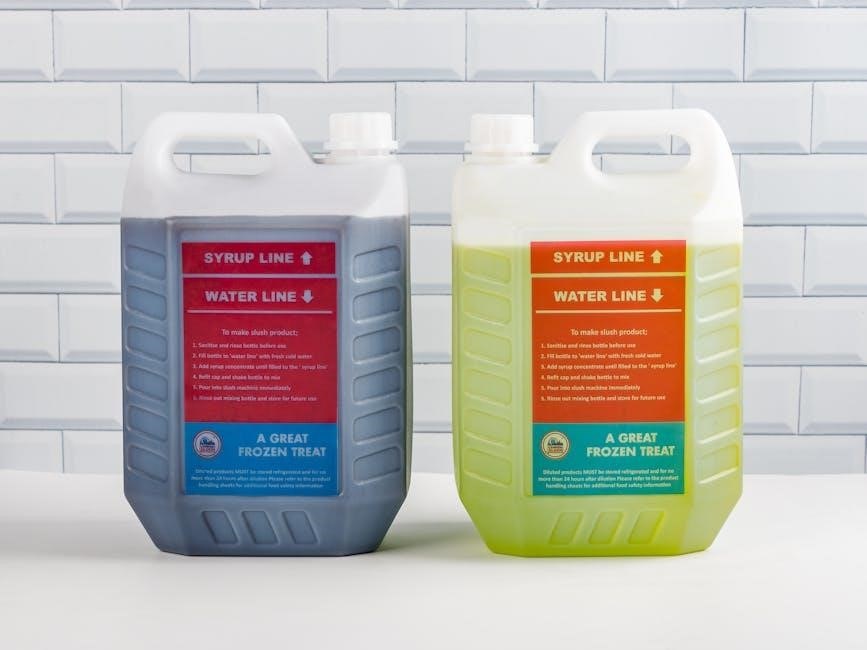Work instructions and SOPs are essential for businesses, ensuring consistency and efficiency․ While SOPs provide high-level guidelines, work instructions offer detailed, task-specific steps, optimizing operational workflows effectively․
Definitions
Standard Operating Procedures (SOPs) outline high-level processes, while Work Instructions (WIs) provide detailed, step-by-step guidance for specific tasks, ensuring clarity and compliance in operational execution․
Standard Operating Procedures (SOPs)
Standard Operating Procedures (SOPs) are detailed, written instructions outlining the steps necessary to complete a specific task or process․ They are typically used to ensure consistency, compliance, and efficiency across an organization․ SOPs are often broad in scope, covering high-level processes that may involve multiple departments or teams․ They provide a clear framework for employees to follow, ensuring that tasks are performed uniformly and in accordance with established standards․ SOPs are essential for maintaining quality control, reducing errors, and promoting regulatory compliance․
Work Instructions (WIs)
Work Instructions (WIs) are detailed, step-by-step guides that outline the specific actions required to complete a task․ Unlike SOPs, they are narrowly focused, providing clear, actionable steps for individual tasks․ WIs are often used when a process requires precise execution, such as in manufacturing or technical roles․ They complement SOPs by offering the granularity needed for frontline employees to perform tasks accurately․ WIs are crucial for ensuring consistency, reducing variability, and minimizing errors in repetitive or complex tasks․
Key Differences
SOPs provide high-level guidance for broader processes, while WIs offer detailed, step-by-step instructions for specific tasks, differing in scope, detail, and application․
Scope and Detail
The primary difference lies in their scope and level of detail․ SOPs are broad, covering entire workflows and providing high-level guidance, while work instructions focus on specific tasks with detailed, step-by-step directions․ SOPs outline general procedures, goals, and responsibilities, often serving as a framework for multiple processes․ In contrast, work instructions are narrow, addressing individual tasks with precise actions, tools, and expected outcomes․ This distinction ensures SOPs remain flexible for various scenarios, whereas WIs are tailored for consistent execution of specific activities, making them indispensable for complex or repetitive tasks․
Application and Use Cases
SOPs are applied to broad, cross-functional processes like order fulfillment or customer onboarding, requiring coordination across multiple teams․ Work instructions, however, are used for specific, repetitive tasks, such as assembly line operations or software troubleshooting․ SOPs ensure consistency across departments, while WIs provide clarity for individual roles․ For example, an SOP might outline the overall customer service process, whereas a WI would detail how to handle a specific customer complaint, step-by-step․ This tailored approach ensures both efficiency and accuracy in execution․
Purpose and Audience
SOPs aim to provide a high-level framework for broader workflows, ensuring that processes are executed consistently across an organization․ They are typically designed for a wide audience, including frontline employees, new team members, and senior managers․ Work instructions, on the other hand, are crafted for specific tasks, targeting individuals who need detailed, step-by-step guidance․ While SOPs serve to standardize operations, work instructions empower employees to perform tasks accurately without extensive prior knowledge, making them indispensable for training and day-to-day operations․
Choosing the Right Document
Selecting between SOPs and work instructions depends on the scope and detail required․ SOPs are ideal for overarching processes, while work instructions suit specific tasks, ensuring clarity and efficiency in operations․
Understanding Business Needs
Understanding business needs is crucial when deciding between SOPs and work instructions․ SOPs are ideal for broad, policy-driven processes, while work instructions are better for detailed, step-by-step tasks․ Assessing whether the process is generalized or requires precise actions helps determine the appropriate document․ If the process involves multiple departments or functions, an SOP might be more suitable․ Conversely, if the task is highly specific and requires detailed guidance, a work instruction would be more effective․ Aligning the document type with the organization’s objectives ensures operational efficiency and clarity․
Evaluating Process Complexity
Evaluating process complexity helps determine whether SOPs or work instructions are more appropriate․ For simpler, repetitive tasks with clear steps, work instructions are ideal․ However, for complex processes involving multiple steps, departments, or requiring a high level of oversight, SOPs are more suitable․ SOPs provide a broader framework, while work instructions focus on detailed execution․ Assessing the complexity ensures the right tool is selected, promoting efficiency and reducing errors․ This alignment is critical for maintaining clarity and ensuring processes are followed consistently across the organization․

Implementation Best Practices
Ensure clarity and conciseness in SOPs and work instructions to avoid overwhelming users․ Regular updates and clear communication are essential for effective implementation and adherence․
Ensuring Clarity and Conciseness
Clarity and conciseness are critical for effective SOPs and work instructions․ Use simple, direct language to avoid ambiguity․ Avoid jargon and ensure terminology is well-defined․ Structuring content logically, with clear headings and bullet points, enhances readability․ Visual aids like flowcharts or diagrams can simplify complex steps․ Review and refine documents regularly to eliminate redundancy․ Ensure each SOP and work instruction is tailored to its audience, providing only essential information․ This approach reduces errors, saves time, and improves compliance with procedures․
Regular Updates and Revisions
Regular updates and revisions are crucial for maintaining the relevance and effectiveness of SOPs and work instructions․ As processes evolve, these documents must be reviewed and updated to reflect current practices․ Establish a version control system to track changes and ensure everyone uses the latest version․ Involve stakeholders in the revision process to capture feedback and improve accuracy․ Training employees on updated procedures is essential to prevent errors and maintain compliance․ Regular audits can identify outdated content, ensuring continuous improvement and alignment with business goals․
Examples and Use Cases
SOPs are ideal for broad processes like order fulfillment, while work instructions detail specific tasks, such as assembly steps or software troubleshooting, ensuring clarity and precision․
SOP Examples in Various Industries
Standard Operating Procedures (SOPs) are widely used across industries to ensure consistency and compliance․ In manufacturing, SOPs might outline production line protocols, while in healthcare, they could govern patient intake procedures․ Retail industries often use SOPs for inventory management and customer service processes․ These documents provide clear, step-by-step guidelines, ensuring tasks are performed uniformly․ By standardizing operations, SOPs help organizations maintain quality, safety, and efficiency, making them indispensable in diverse sectors․ Their adaptability ensures they remain a cornerstone of operational excellence․
WI Examples for Specific Tasks
Work Instructions (WIs) are detailed guides for completing specific tasks․ For example, in IT, a WI might outline step-by-step software installation procedures․ In manufacturing, WIs could specify assembly line sequences or quality control checks․ These documents are highly detailed, ensuring employees follow exact steps to achieve consistent results․ Unlike SOPs, WIs are narrowly focused, providing actionable instructions for individual tasks rather than overarching processes․ They are particularly useful in complex or repetitive roles, ensuring accuracy and efficiency in task execution across various industries․ Their specificity makes them invaluable for operational precision․

Integration and Compliance
Integrating SOPs and WIs ensures seamless process execution, while compliance with regulations and standards guarantees operational integrity and avoids legal risks, aligning business practices with industry requirements effectively․
Combining SOPs and WIs
Combining SOPs and work instructions creates a comprehensive operational framework․ SOPs provide overarching guidelines, while WIs detail specific tasks, ensuring clarity and consistency․ This integration streamlines processes, reduces errors, and enhances efficiency․ For example, an SOP might outline the overall order fulfillment process, while WIs break it down into step-by-step actions for each employee․ This layered approach allows businesses to maintain flexibility and scalability, ensuring compliance and adaptability to changing demands․
Ensuring Regulatory Compliance
Both SOPs and work instructions play a crucial role in ensuring regulatory compliance․ SOPs establish a standardized framework that aligns with industry regulations, while work instructions provide detailed steps to meet specific compliance requirements․ By integrating these documents, businesses can ensure adherence to legal and safety standards․ Regular audits and updates of SOPs and WIs help maintain compliance, reducing risks of non-conformity․ This structured approach ensures that all processes are not only efficient but also aligned with regulatory expectations, safeguarding the organization’s operations and reputation․ Compliance is thus embedded into the core of daily activities․

Training and Communication
SOPs and work instructions are vital for effective employee training and communication, ensuring clarity and consistency across processes and roles within an organization․
Effective Employee Training
Effective employee training involves clearly communicating SOPs and work instructions to ensure understanding and compliance․ SOPs provide a broad framework, while work instructions detail specific tasks․ Training should emphasize the importance of following these documents to maintain consistency and reduce errors․ Employees benefit from hands-on exercises and real-life examples, allowing them to apply SOPs and work instructions effectively․ Regular updates and refresher sessions help keep teams aligned with evolving processes and standards․
Clear Communication Strategies
Clear communication is vital for ensuring employees understand and apply SOPs and work instructions effectively․ SOPs should be communicated broadly, emphasizing their role in overarching processes, while work instructions should be shared directly with those performing specific tasks․ Using simple, concise language and providing visual aids can enhance clarity․ Regular updates and reminders ensure everyone stays informed․ Tailoring communication to the audience, whether frontline workers or managers, helps prevent misunderstandings and ensures alignment with business goals․

Continuous Improvement
Continuous improvement involves regularly reviewing and refining SOPs and work instructions․ Feedback from employees and performance metrics help identify areas for enhancement, ensuring processes remain efficient and effective․
Implementing Feedback Loops
Feedback loops are crucial for continuous improvement․ Regularly collecting input from employees ensures SOPs and work instructions stay relevant and effective․ By fostering a culture of open communication, organizations can identify inefficiencies and make timely adjustments․ This iterative process not only enhances productivity but also empowers employees to contribute to process optimization, leading to better alignment with business goals and improved overall performance․
Monitoring Performance Metrics
Monitoring performance metrics is essential to evaluate the effectiveness of SOPs and work instructions․ By tracking key indicators such as task completion rates, error frequencies, and process cycle times, organizations can assess operational efficiency․ Regular audits ensure compliance with established standards, while performance data helps identify areas needing improvement․ Aligning metrics with business objectives ensures that SOPs and work instructions remain relevant and effective, driving continuous improvement and operational excellence․



